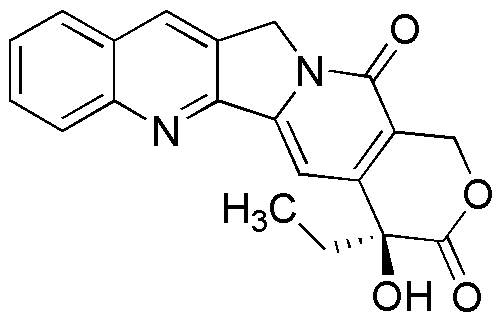(S)-(+)-Camptothecin is widely utilized in research focused on
- Cancer Treatment: This compound is primarily known for its potent anti-cancer properties, particularly in the treatment of various types of cancer such as colorectal and ovarian cancers. It works by inhibiting DNA topoisomerase I, which is crucial for DNA replication.
- Pharmaceutical Development: Researchers are actively exploring its derivatives to enhance efficacy and reduce side effects. This process is vital for developing new chemotherapy drugs that can target cancer cells more effectively.
- Drug Formulation: (S)-(+)-Camptothecin is used in formulating targeted drug delivery systems. These systems aim to improve the bioavailability of the drug, ensuring that more of it reaches the tumor site while minimizing exposure to healthy tissues.
- Research on Mechanisms of Action: It serves as a key compound in studies investigating the mechanisms of cancer cell resistance. Understanding these mechanisms can lead to better treatment strategies and improved patient outcomes.
- Combination Therapies: This compound is often studied in combination with other chemotherapeutic agents to assess synergistic effects, potentially leading to more effective treatment regimens that can overcome drug resistance.
General Information
Properties
Safety and Regulations
Applications
(S)-(+)-Camptothecin is widely utilized in research focused on
- Cancer Treatment: This compound is primarily known for its potent anti-cancer properties, particularly in the treatment of various types of cancer such as colorectal and ovarian cancers. It works by inhibiting DNA topoisomerase I, which is crucial for DNA replication.
- Pharmaceutical Development: Researchers are actively exploring its derivatives to enhance efficacy and reduce side effects. This process is vital for developing new chemotherapy drugs that can target cancer cells more effectively.
- Drug Formulation: (S)-(+)-Camptothecin is used in formulating targeted drug delivery systems. These systems aim to improve the bioavailability of the drug, ensuring that more of it reaches the tumor site while minimizing exposure to healthy tissues.
- Research on Mechanisms of Action: It serves as a key compound in studies investigating the mechanisms of cancer cell resistance. Understanding these mechanisms can lead to better treatment strategies and improved patient outcomes.
- Combination Therapies: This compound is often studied in combination with other chemotherapeutic agents to assess synergistic effects, potentially leading to more effective treatment regimens that can overcome drug resistance.
Documents
Safety Data Sheets (SDS)
The SDS provides comprehensive safety information on handling, storage, and disposal of the product.
Product Specification (PS)
The PS provides a comprehensive breakdown of the product’s properties, including chemical composition, physical state, purity, and storage requirements. It also details acceptable quality ranges and the product's intended applications.
Certificates of Analysis (COA)
Search for Certificates of Analysis (COA) by entering the products Lot Number. Lot and Batch Numbers can be found on a product’s label following the words ‘Lot’ or ‘Batch’.
*Catalog Number
*Lot Number
Certificates Of Origin (COO)
This COO confirms the country where the product was manufactured, and also details the materials and components used in it and whether it is derived from natural, synthetic, or other specific sources. This certificate may be required for customs, trade, and regulatory compliance.
*Catalog Number
*Lot Number
Safety Data Sheets (SDS)
The SDS provides comprehensive safety information on handling, storage, and disposal of the product.
DownloadProduct Specification (PS)
The PS provides a comprehensive breakdown of the product’s properties, including chemical composition, physical state, purity, and storage requirements. It also details acceptable quality ranges and the product's intended applications.
DownloadCertificates of Analysis (COA)
Search for Certificates of Analysis (COA) by entering the products Lot Number. Lot and Batch Numbers can be found on a product’s label following the words ‘Lot’ or ‘Batch’.
*Catalog Number
*Lot Number
Certificates Of Origin (COO)
This COO confirms the country where the product was manufactured, and also details the materials and components used in it and whether it is derived from natural, synthetic, or other specific sources. This certificate may be required for customs, trade, and regulatory compliance.


